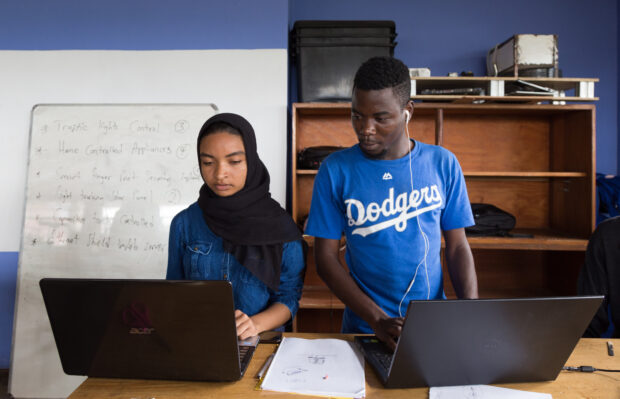The climate crisis and digital transformation. At first glance, these two concepts seem independent from each other. In reality, an inclusive, competitive, and sustainable digital public infrastructure can have a truly impactful effect on the fight against climate change. The intertwining of these two concepts is what we call the ‘twin transition’, an effort to use digital public infrastructure to mitigate and get ahead of the effects of climate change, as well as ensure that we are keeping digital ecosystems eco-friendly.
So, why is digital public infrastructure so important for reducing the effects of climate change and reaching our global climate goals? The clock is ticking on the climate agenda. The recent IPCC synthesis report highlights that we are not adapting and implementing measures to tackle the climate crisis quickly enough and that these gaps in public infrastructure will only continue to grow the longer they are ignored. Decades of lukewarm discussion among world leaders have not inspired confidence that future generations will be able to live comfortably and securely in our changing environment. There is a vital need for the global community, individual governments, and national policymakers to take coordinated and intelligent steps to make our planet better for everyone, everywhere, and save millions, if not billions, from the impending tragedies that the climate crisis poses. Digital is a clear path forward.
Realizing the twin transition
To truly make the most out of the twin transition, the implementers of digital public infrastructure must view climate through two lenses: greening by digital and greening of digital.
‘Greening by digital’ ensures that digital public infrastructure is being used to mitigate and get ahead of the effects of climate change. This goes beyond explicit climate-fighting tech, such as powering renewable energy or driving electric cars, but looks more holistically about how individuals interacting with the climate crisis can be best protected and take advantage of the opportunities presented by digital. Concurrently, the ‘greening of digital’ aims to ensure that any digital public infrastructure, whether it already exists or will be created in the future, operates under standards which respect the environment and contribute to achieving our global climate goals. Before we use technology to help fight the climate crisis, we must ensure that we are not adding fuel to the fire.
A key component of greening by digital is ensuring that individuals and communities across the world are able to be resilient in the face of a climate emergency. Increasingly, we are seeing catastrophic floods, wildfires, hurricanes, among many other natural disasters, not only taking lives, but leaving those who survive with little to their name. This includes essentials, such as identification or access to money. During last year’s floods in Pakistan, the rollout of the “Asaan Mobile Account” Scheme allowed flood-affected people, particularly those that were underbanked, to receive emergency funding immediately via digital transfers. Governments and policymakers need to implement inclusive digital public infrastructure as a matter of urgency, so those affected by climate-caused emergencies have access to the basics they need to survive, and emergency coordination and recovery efforts are quicker more efficient, and ultimately help foster climate resilience.
However, implementing and maintaining digital public infrastructure does not come without its challenges. Like any infrastructure project, one must consider the potential environmental and cultural effects of uphauling and reinventing a nation’s way of operating. There is the risk of extreme energy consumption and e-waste, as well as the need for copious amounts of land, which obviously work against our climate goals. In addition, a transition to digital will affect the way individuals behave in their everyday lives, as well as creating additional hurdles for businesses, despite the outcome being universally beneficial. When thinking about the greening of digital, governments and policymakers must ensure that we are not exacerbating existing prejudices and negative power dynamics that we see in our existing infrastructure. This means implementing policies, oversight and accountability, and capacity to realize the opportunities presented by these digital technologies.
So, how do we avoid these risks posing problems for digital public infrastructure and negatively impacting individuals’ lives? Governments must view their infrastructure from a people-first and a climate-first lens. This means listening to communities’ thoughts and concerns, operating in a transparent and trustworthy way, and following trusted climate advice every step of the way. We know these risks exist, but they are in no way blockers to implementing and sustaining successful digital public infrastructure.
The path forward
Digital technology is rapidly transforming how we live our lives. Rather than seeing it as a concurrent agenda to our climate goals, we must recognize the potential of harnessing the power of digital public infrastructure to help us adapt to climate change. From data sharing for mitigation efforts to optimizing crisis support via digital payments, there are vast opportunities once we realize how both agendas interact.
In order to meet urgent climate goals, we must consider how governments and the global community can fund DPI, especially guaranteeing that any digital transformation or digital public infrastructure is safe, sustainable, and inclusive for everyone, everywhere.
Getting this right is crucial. That’s why, at the Digital Impact Alliance, we’re investing in more research, more advocacy, and more empowerment for climate. This means working together with experts, governments around the world, and global bodies in order to ensure we are delivering individuals around the world with the best opportunities to counter challenges posed by the climate crisis, and thrive in a clean, sustainable, and digital world.





